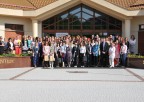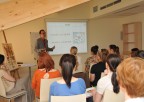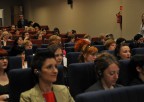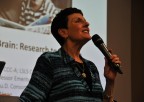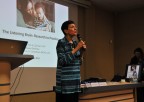4th International Scientific -Training Conference “Listening is: I can. Auditory-Verbal Therapy. All Roads Lead to the Brain.” took place in the World Hearing Center of the Institute of Physiology and Pathology of Hearing in Kajetany on May 16-17, 2013.
In the conference participated more than 100 specialists in rehabilitation of deaf and hearing impaired children from the whole Poland, as well as parents and caretakers of implanted children.
In the scientific program an important place held the lectures on the auditory development of child’s brain presented by Prof. Carol Flexer, PhD, the special guest of the conference. Prof. Carol Flexer is an eminent audiologist, well known and respected lecturer in pediatric and educational audiology, certified LSLS (Auditory-Verbal Therapy specialist).
Auditory-Verbal Therapy – AVT method is based on developing speech in the auditory way, without using lip reading or sign language. The methods promotes early detection and diagnosis of hearing loss, followed by the application of the modern technology, that is an appropriate device supporting hearing. Early detection and provision with technology are aimed at stimulating the growth of the developing brain of the child, subjecting the appropriate brain structures to the intensive stimulation to facilitate the development of normal hearing and to allow these structures to perform their normal physiological functions. AVT uses techniques, strategies and principles promoting the optimal development of spoken language through listening.
Prof. Flexer stressed many times that listening is one of the most important paths of personal and social development of a child and the auditory-verbal method assumes that parents actively participate in the rehabilitation process. Parents are not only present during therapy sessions, they take an active part learning the proper techniques and strategies to use them later in their everyday interactions with their child. In comparison to the other early rehabilitation programs, the Auditory-Verbal Therapy method requires greater commitment not only from the therapist, but from all participants of the therapy.
Assuming an active participation of parents in child’s therapy, the Auditory-Verbal Therapy expects that they should be prepared to that role. Parents are therapists’ real ‘clients’. Developing a program of each session, therapist sets specific hearing, speech, language, learning and communication goals. This allows regular monitoring of child’s progress, as each session is also a diagnostic meeting.
By engaging the parents, the therapist prepares them to monitor regularly child’s progress against the development norm. AVT method puts stress on education, counseling and family support. Its goals are developing children’s listening, speaking and conversation skills to enable them attending the mainstream schools and to give them the choice in their academic and professional future.
Beside these extremely interesting lectures, the conference program included numerous workshops, during which participants trained the techniques of working with patients and their parents basing on their own experience, recordings and films from their own sessions and case studies.
Workshops were conducted by specialists from the Institute of Physiology and Pathology of Hearing and the graduates of the only in Poland training course in the Auditory-Verbal Therapy method – Listening for Life© Auditory – Verbal Studies: Principles into Practice, organized by WE Listen International Inc. and the Institute.
The most important, optimistic lesson to take home from the Conference in Kajetany was that the current state of the art and available technology, such as cochlear implants and hearing aids, combined with the suitably early commenced, regular work with a child engaging brain’s development potential, allow today’s children with any level of a hearing loss to develop spoken language, literacy and social and emotional skills to the never before expected degree.






